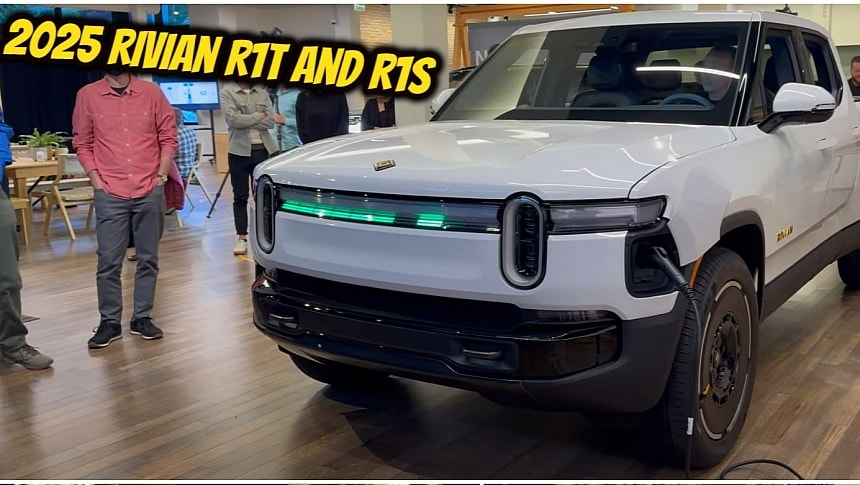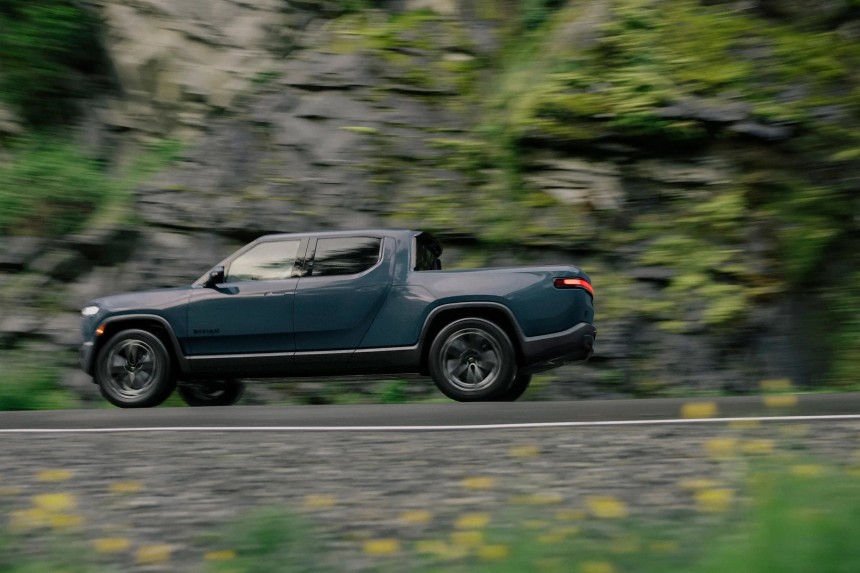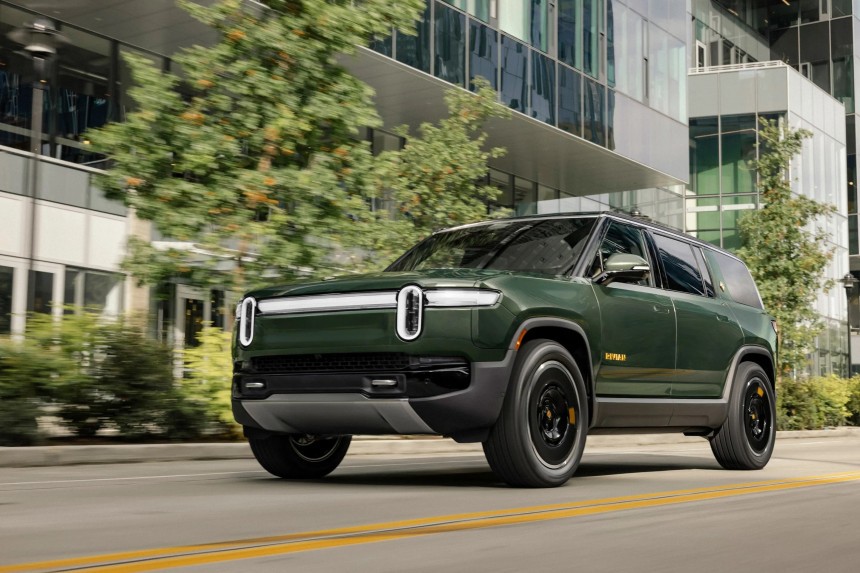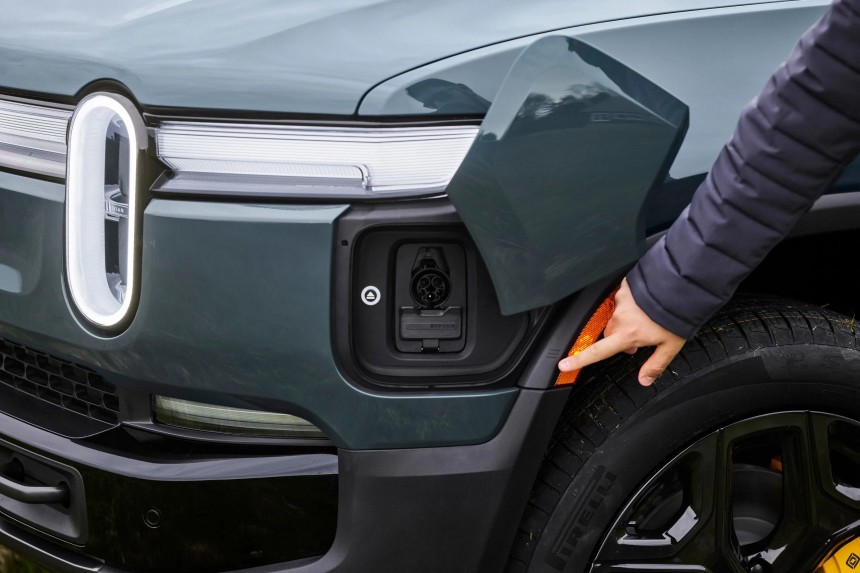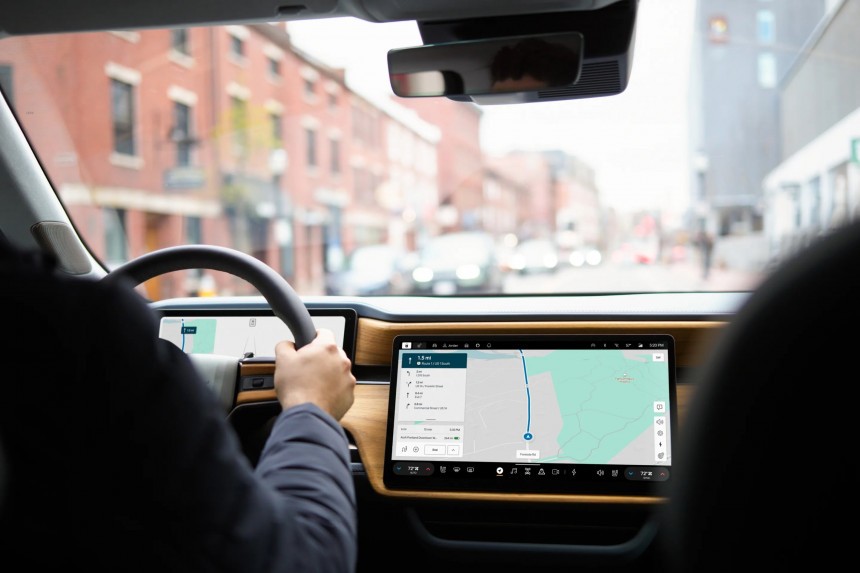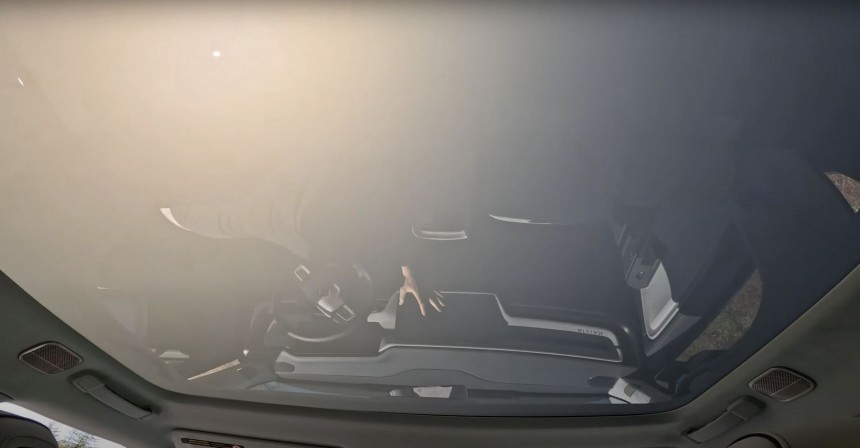Rivian made a couple of changes to its R1-series lineup. The pickup truck and the SUV feature better tech, updated internals, cool graphics, new interior materials and trim, fresh wheels, different tires, and more. Here's what you need to know.
Even though it may look like Rivian didn't change much about its two main electric vehicles (EVs), it's worth underlining from the get-go that the 2025 R1T and 2025 R1S pack over 600 improvements. We can't dissect everything, so here's what matters most.
First, the price: the R1T starts at $69,900, while the most affordable R1S is $75,900. At the time of writing, 2025 model-year units have already hit the automaker's official vehicle shop. Prices vary from $76,650 all the way to nearly $102,000 for a dual-motor "Performance" R1S with the Max Pack battery and 22-inch wheels.
Here's how pricing looks for all the trims available at launch:
The performance upgrade is available for dual-motor + large battery pack configurations of both EVs. It costs $5,000 and unlocks an extra 132 hp and 219 lb-ft of torque from the in-house developed and oil-cooled Enduro permanent magnet drive units.
The tri-motor powertrain enables the refreshed R1S and the R1T to reach 60 mph (97 kph) from a standstill in 2.9 seconds.
Rivian says the new motors are a bit more silent, which should translate into a better cabin experience.
The quad-motor variants (which come with unique badging and blue brake calipers) develop a supercar-like 1,025 hp and 1,198 lb-ft of torque, which translates into a zero-to-60 mph time of under 2.5 seconds (on a prepped drag strip surface with warm tires). That should enable Rivian's R1-series EVs to smoke Tesla's tri-motor Cyberbeast, which needs 2.6 seconds (with rollout subtracted) to display 60 mph on the only display that doubles as an instrument panel.
However, you can't beat a vehicle that exists with one that's supposed to come. Rivian bought itself some more time to play with the quad-motor powertrain, which feels a bit unfair. Let's hope it'll live up to the hype. You can see how some YouTubers and journalists reacted to the early version of the new quad-motor setup in the videos below.
The high-voltage energy storage units don't come with an upgraded voltage architecture. They're still ~400V packs, which means peak charging power is limited to 200 – 220 kW.
The standard battery pack features a lithium iron phosphate (LFP chemistry and holds 92.5 kWh of usable energy. It can draw power at a maximum rate of 200 kW but don't expect the charging curve to be mesmerizing. According to Rivian's own data, it needs 34 minutes at a DC pedestal to recharge from 10 to 80 percent.
The large and max-pack batteries hold 109.4 kWh and 141.5 kWh of energy, respectively. Both are equipped with nickel manganese cobalt (NMC) cathodes and are made of Samsung's 53G cells. These two have a peak charging power of 220 kW.
If you buy an inventory 2025 R1S or 2025 R1T, the vehicle will come with a CCS port. You won't be able to charge without an adapter at a Tesla Supercharger station.
Rivian listened to customer feedback and updated the R1S suspension. The new air springs and a slightly different suspension tuning should eliminate that porpoising behavior. New dampers and bushings should help make the R1S cabin feel a bit more silent and comfortable.
As for more cool updates many people won't be aware of, the new in-house developed heat pump eliminates the need for any electrical resistance heater. The front and rear motors will run inefficiently to heat up the battery. When there's excess heat, the pump uses it to heat up the cabin efficiently.
Continuing, rumors that Rivian would license Tesla's Full Self-Driving software are now quashed. The automaker chose Nvidia power, ultrasonic sensors, and radars to upgrade the autonomy capabilities of the refreshed R1S and R1T. Driver+ should be better and continue to improve over time.
Third, the light bar is now RGB and has useful applications, such as showing what your battery charge level is from afar. You won't have to check the phone or the DCFC's screen. When stranded, activating the hazards also turns on the lightbar. It lights up red for increased visibility.
Fourth, there are new rim and tire options. The $2,000 22-inch aero wheels with a detachable cover increase the range by about three miles. The other options are 20- or 22-inch. The latter is also available in a staggered setup for the quad-motor R1T and R1S, where the front wheels are one inch wider than the rear wheels. Interestingly enough, the 3D-printed Michelin Pilot Sport 5S rubber ring measures 305 mm in width when installed on the rear rims and 275 mm when wrapped around the front rims.
Fifth, inside, there's new software that'll trickle down to existing models and mood lighting. Seven colors are available.
Next, there's a blind spot camera that appears in the driver's display when indicating, buttons for the door latches with physical backups, new graphics, and new materials.
Rivian uses Unreal Engine to provide playful illustrations to the driver and the front passenger.
Instead of a sunshade, Rivian gave the Peregrine R1T and R1S an electrochromic roof that works just like the one we've seen on the Porsche Taycan GTS.
Something Rivian forgot to add is the vehicle-to-home capability, an option the Ford F-150 Lightning, the Tesla Cybertruck, and the Chevy Silverado EV do have.
In conclusion, this is a nice refresh that improves both the R1T and the R1S. It gives the EVs a new slice of life and offers customers the chance to experience a zero-tailpipe emission lifestyle that doesn't end when leaving the city limits. There's still a lot of work left, but the future of this American brand looks bright.
On a side note, I think it's worth pointing out that when the first electrochromic sunroof debuted on the V12-powered Maybach 62 in 2004, it was an option that cost $12,000. If you wanted to reach 60 mph in 2.5 seconds, you had to buy a $1.3 million Bugatti Veyron. Today, a six-figure battery-powered pickup truck can do both. Wild.
First, the price: the R1T starts at $69,900, while the most affordable R1S is $75,900. At the time of writing, 2025 model-year units have already hit the automaker's official vehicle shop. Prices vary from $76,650 all the way to nearly $102,000 for a dual-motor "Performance" R1S with the Max Pack battery and 22-inch wheels.
Here's how pricing looks for all the trims available at launch:
- R1T
- Dual-motor (533 hp and 610 lb-ft of torque) + standard 270-mile battery pack – $69,900;
- Dual-motor (533 hp and 610 lb-ft of torque) + large 330-mile battery pack – $76,900;
- Dual-motor (533 hp and 610 lb-ft of torque) + max 420-mile battery pack – $83,900;
- Tri-Motor (850 hp and 1,103 lb-ft of torque) + max 380-mile battery pack – $99,900.
- R1S
- Dual-motor (533 hp and 610 lb-ft of torque) + standard 270-mile battery pack – $75,900;
- Dual-motor (533 hp and 610 lb-ft of torque) + large 330-mile battery pack – $82,900;
- Dual-motor (533 hp and 610 lb-ft of torque) + max 410-mile battery pack – $89,900;
- Tri-Motor (850 hp and 1,103 lb-ft of torque) + max 380-mile battery pack – $105,900.
The performance upgrade is available for dual-motor + large battery pack configurations of both EVs. It costs $5,000 and unlocks an extra 132 hp and 219 lb-ft of torque from the in-house developed and oil-cooled Enduro permanent magnet drive units.
Rivian says the new motors are a bit more silent, which should translate into a better cabin experience.
An ongoing success story
Deliveries start on June 7. However, customers who want a particular configuration must wait until fall. Quad-motor R1Ts and R1S' are dropping next year. Pricing for Rivian's most powerful pickup truck and three-row SUV is unknown.The quad-motor variants (which come with unique badging and blue brake calipers) develop a supercar-like 1,025 hp and 1,198 lb-ft of torque, which translates into a zero-to-60 mph time of under 2.5 seconds (on a prepped drag strip surface with warm tires). That should enable Rivian's R1-series EVs to smoke Tesla's tri-motor Cyberbeast, which needs 2.6 seconds (with rollout subtracted) to display 60 mph on the only display that doubles as an instrument panel.
The high-voltage energy storage units don't come with an upgraded voltage architecture. They're still ~400V packs, which means peak charging power is limited to 200 – 220 kW.
The standard battery pack features a lithium iron phosphate (LFP chemistry and holds 92.5 kWh of usable energy. It can draw power at a maximum rate of 200 kW but don't expect the charging curve to be mesmerizing. According to Rivian's own data, it needs 34 minutes at a DC pedestal to recharge from 10 to 80 percent.
The large and max-pack batteries hold 109.4 kWh and 141.5 kWh of energy, respectively. Both are equipped with nickel manganese cobalt (NMC) cathodes and are made of Samsung's 53G cells. These two have a peak charging power of 220 kW.
Major profit-boosting improvements
Second, as we reported last year, the engineers spent a lot of time simplifying the internals of both the R1T and R1S. They've eliminated over 1.6 miles (2.6 kilometers) of wiring from each EV and removed 10 computers. That brings the costs down and makes the EVs lighter. Everybody wins.Rivian listened to customer feedback and updated the R1S suspension. The new air springs and a slightly different suspension tuning should eliminate that porpoising behavior. New dampers and bushings should help make the R1S cabin feel a bit more silent and comfortable.
As for more cool updates many people won't be aware of, the new in-house developed heat pump eliminates the need for any electrical resistance heater. The front and rear motors will run inefficiently to heat up the battery. When there's excess heat, the pump uses it to heat up the cabin efficiently.
Continuing, rumors that Rivian would license Tesla's Full Self-Driving software are now quashed. The automaker chose Nvidia power, ultrasonic sensors, and radars to upgrade the autonomy capabilities of the refreshed R1S and R1T. Driver+ should be better and continue to improve over time.
Nifty updates
Rivian replaced the fog lights (which were integrated into the stadium-shaped headlamps) with turning indicators because the headlights have matrix functionality and can provide enough light even in adverse weather conditions. The daytime running lights (DRLs) now remain fully on even when you're indicating a turn.Fourth, there are new rim and tire options. The $2,000 22-inch aero wheels with a detachable cover increase the range by about three miles. The other options are 20- or 22-inch. The latter is also available in a staggered setup for the quad-motor R1T and R1S, where the front wheels are one inch wider than the rear wheels. Interestingly enough, the 3D-printed Michelin Pilot Sport 5S rubber ring measures 305 mm in width when installed on the rear rims and 275 mm when wrapped around the front rims.
Fifth, inside, there's new software that'll trickle down to existing models and mood lighting. Seven colors are available.
Rivian uses Unreal Engine to provide playful illustrations to the driver and the front passenger.
The future is here and it looks great
The non-grippy wireless charging pad installed on the center console isn't cooled but features a divider, so two phones can charge simultaneously without interfering with each other. Still, you'll have to pay attention when braking because there's no front lip, and the devices could slide forward and fall down.Instead of a sunshade, Rivian gave the Peregrine R1T and R1S an electrochromic roof that works just like the one we've seen on the Porsche Taycan GTS.
In conclusion, this is a nice refresh that improves both the R1T and the R1S. It gives the EVs a new slice of life and offers customers the chance to experience a zero-tailpipe emission lifestyle that doesn't end when leaving the city limits. There's still a lot of work left, but the future of this American brand looks bright.
On a side note, I think it's worth pointing out that when the first electrochromic sunroof debuted on the V12-powered Maybach 62 in 2004, it was an option that cost $12,000. If you wanted to reach 60 mph in 2.5 seconds, you had to buy a $1.3 million Bugatti Veyron. Today, a six-figure battery-powered pickup truck can do both. Wild.
"We continue to evolve our flagship R1 vehicles, offering quality and performance without compromise. Our revamped R1S and R1T push the technical boundaries further, creating our most capable products to date.” - @RJScaringe, Rivian CEO and founder
— Rivian (@Rivian) June 6, 2024
Meet the new R1. More capable,… pic.twitter.com/AYFigupEKu
